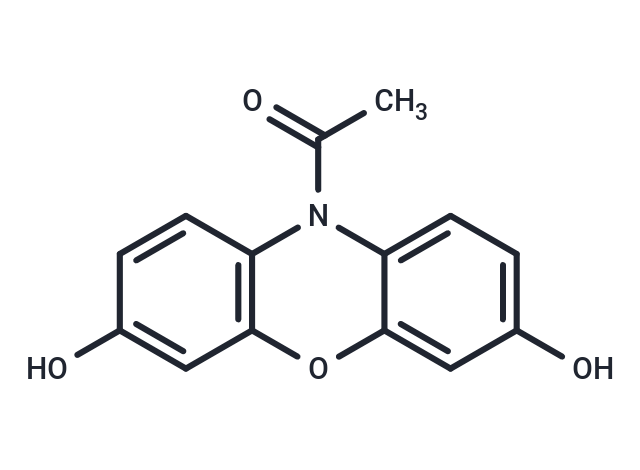Shopping Cart
- Remove All
 Your shopping cart is currently empty
Your shopping cart is currently empty

ADHP (10-Acetyl-3,7-dihydroxyphenoxazine) is a fluorogenic peroxidase substrate (λex=530 nm, λem=590 nm).

| Pack Size | Price | Availability | Quantity |
|---|---|---|---|
| 1 mg | $35 | In Stock | |
| 5 mg | $98 | In Stock | |
| 10 mg | $148 | In Stock | |
| 25 mg | $248 | In Stock | |
| 50 mg | $372 | In Stock | |
| 100 mg | $546 | In Stock | |
| 1 mL x 10 mM (in DMSO) | $91 | In Stock |
| Description | ADHP (10-Acetyl-3,7-dihydroxyphenoxazine) is a fluorogenic peroxidase substrate (λex=530 nm, λem=590 nm). |
| In vitro | To obtain the parameters Km and kcat for Compound I, two independent methods are used. Initially, the oxidation of ADHP using the injector functionality built-in to the fluorescence plate reader is studied. The auto-injector dispenses the H2O2 to initiate the reaction, as a means of generating a set of progress curves. Analysis for MPO-mediated oxidation of ADHP gives a Km of 31±4 μM and the kcat of 186± 6/s. The kobs also increase over the experimental range of ADHP concentrations from 1 to 80 μM and for the converse experiment holding substrate constant over 3 to 45 nM MPO. The apparent second-order rate constant obtain from the slope of kobs against ADHP concentration Kappon is 2.1±0.2 mM/s. |
| Alias | 10-Acetyl-3,7-dihydroxyphenoxazine |
| Molecular Weight | 257.24 |
| Formula | C14H11NO4 |
| Cas No. | 119171-73-2 |
| Smiles | OC1=CC=C2C(OC(C=C(O)C=C3)=C3N2C(C)=O)=C1 |
| Relative Density. | 1.459g/cm3 |
| Storage | store at low temperature,store under nitrogen,keep away from direct sunlight | Powder: -20°C for 3 years | In solvent: -80°C for 1 year | Shipping with blue ice. | |||||||||||||||||||||||||||||||||||
| Solubility Information | DMSO: 60 mg/mL (233.25 mM), Sonication is recommended. | |||||||||||||||||||||||||||||||||||
Solution Preparation Table | ||||||||||||||||||||||||||||||||||||
DMSO
| ||||||||||||||||||||||||||||||||||||

Copyright © 2015-2025 TargetMol Chemicals Inc. All Rights Reserved.